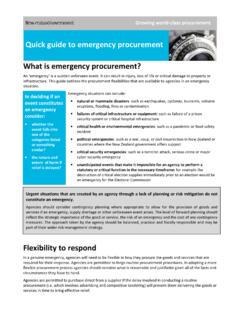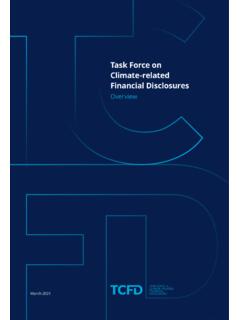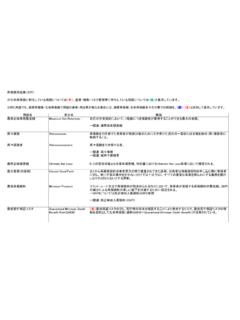Transcription of Education during COVID-19 and beyond
1 Policy Brief: Education during COVID-19 . and beyond AUGUST 2020. Executive summary The COVID-19 pandemic has created the As fiscal pressures increase, and development largest disruption of Education systems in assistance comes under strain, the financing history, affecting nearly billion learners of Education could also face major challenges, in more than 190 countries and all conti- exacerbating massive pre- COVID-19 Education nents. Closures of schools and other learn- funding gaps. For low income countries and low- ing spaces have impacted 94 per cent of the er-middle-income countries, for instance, that world's student population, up to 99 per cent gap had reached a staggering $148 billion annu- in low and lower-middle income countries.
2 Ally and it could now increase by up to one-third. On the other hand, this crisis has stimulated The crisis is exacerbating pre-existing educa- innovation within the Education sector. We have tion disparities by reducing the opportunities seen innovative approaches in support of edu- for many of the most vulnerable children, youth, cation and training continuity: from radio and and adults those living in poor or rural areas, television to take-home packages. Distance girls, refugees, persons with disabilities and learning solutions were developed thanks to forcibly displaced persons to continue their quick responses by governments and partners learning.
3 Learning losses also threaten to extend all over the world supporting Education conti- beyond this generation and erase decades nuity, including the Global Education Coalition of progress, not least in support of girls and covened by UNESCO. We have also been young women's educational access and reten- reminded of the essential role of teachers and tion. Some million additional children and that governments and other key partners have youth (from pre-primary to tertiary) may drop an ongoing duty of care to Education personnel. out or not have access to school next year due But these changes have also highlighted that the to the pandemic's economic impact alone.
4 Promising future of learning, and the accelerated changes in modes of delivering quality educa- Similarly, the Education disruption has had, tion, cannot be separated from the imperative of and will continue to have, substantial effects leaving no one behind. This is true for children beyond Education . Closures of educational and youth affected by a lack of resources or institutions hamper the provision of essen- enabling environment to access learning. It is tial services to children and communities, true for the teaching profession and their need including access to nutritious food, affect the for better training in new methods of educa- ability of many parents to work, and increase tion delivery, as well as support.
5 Last but not risks of violence against women and girls. least, this is true for the Education community 2 POLICY BRIEF: Education during COVID-19 AND beyond . at large, including local communities, upon > SUPPRESS TRANSMISSION OF THE VIRUS. whom Education continuity depends during AND PLAN THOROUGHLY FOR SCHOOL. crisis and who are key to building back better. RE-OPENINGS: The single most significant step that countries can take to hasten The COVID-19 crisis and the unparalleled edu- the reopening of schools and Education cation disruption is far from over.
6 As many institutions is to suppress transmission as 100 countries have yet to announce a date of the virus to control national or local for schools to reopen and across the world, outbreaks. Once they have done so, to deal governments, unions, parents and children are with the complex challenge of reopening, it grappling with when and how to approach the is important to be guided by the following next phase. Countries have started planning parameters: ensure the safety of all; plan to reopen schools nationwide, either based on for inclusive re-opening; listen to the voices grade level and by prioritizing exam classes, or of all concerned; and coordinate with key through localized openings in regions with fewer actors, including the health cases of the virus.
7 However, given the continued virulence of the virus, the majority of countries > PROTECT Education FINANCING AND. surveyed in May June 2020 had yet to decide COORDINATE FOR IMPACT: The pandemic on a reopening date. These decisions carry has pushed the world into the deepest enormous social and economic implications global recession in living memory which and will have lasting effects on educators, on will have lasting effects on economies children and youth, on their parents especially and public finances. National authorities women and indeed on societies as a whole.
8 And the international community need to protect Education financing through the following avenues: strengthen domestic Recommendations revenue mobilization, preserve the share of expenditure for Education as a Preventing a learning crisis from top priority and address inefficiencies becoming a generational catastrophe in Education spending; strengthen requires urgent action from all. international coordination to address the Education is not only a fundamental human debt crisis; and protect official development right. It is an enabling right with direct impact assistance (ODA) for Education .
9 On the realization of all other human rights. > BUILD RESILIENT Education SYSTEMS. It is a global common good and a primary FOR EQUITABLE AND SUSTAINABLE. driver of progress across all 17 Sustainable DEVELOPMENT: Strengthening the Development Goals as a bedrock of just, equal, resilience of Education systems enables inclusive peaceful societies. When Education countries to respond to the immediate systems collapse, peace, prosperous and challenges of safely reopening schools productive societies cannot be sustained. and positions them to better cope with In order to mitigate the potentially devastating future crises.
10 In this regard, governments consequences of the COVID-19 pandemic, gov- could consider the following: focus on ernments and stakeholders are encouraged equity and inclusion; reinforce capacities to pursue the following policy responses: for risk management , at all levels of the 1 Guidance is available from the United Nations and other Education partners. POLICY BRIEF: Education during COVID-19 AND beyond 3. system; ensure strong leadership and following entry points could be to the coordination; and enhance consultation fore of our efforts: focus on addressing and communication mechanisms.














